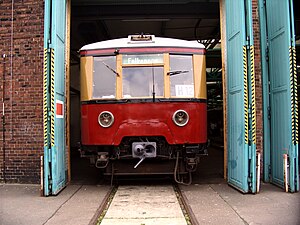
The Berlin U-Bahn is a rapid transit system in Berlin, the capital and largest city of Germany, and a major part of the city's public transport system. Together with the S-Bahn, a network of suburban train lines, and a tram network that operates mostly in the eastern parts of the city, it serves as the main means of transport in the capital.
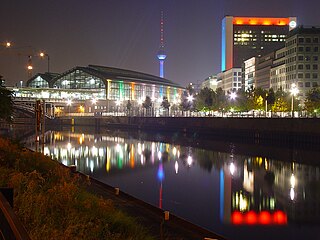
The Berlin S-Bahn is a rapid transit railway system in and around Berlin, the capital city of Germany. It has been in operation under this name since December 1930, having been previously called the special tariff area Berliner Stadt-, Ring- und Vorortbahnen. It complements the Berlin U-Bahn and is the link to many outer-Berlin areas, such as Berlin Brandenburg Airport. As such, the Berlin S-Bahn blends elements of a commuter rail service and a rapid transit system.

The Hamburg U-Bahn is a rapid transit system serving the cities of Hamburg, Norderstedt, and Ahrensburg in Germany. Although referred to by the term U-Bahn, most of the system's track length is above ground. The network is interconnected with the city's S-Bahn system, which also has underground sections. It is operated by Hamburger Hochbahn within the Hamburger Verkehrsverbund (HVV). It was opened in February 1912, and comprises four lines serving 93 stations, with a route length of 106.4 kilometres (66.1 mi) in 2019.
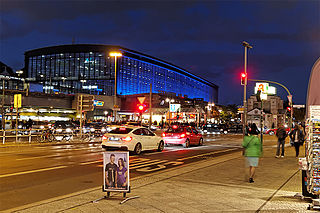
Berlin Zoologischer Garten station is a railway station in Berlin, Germany. It is located on the Berlin Stadtbahn railway line in the Charlottenburg district, adjacent to the Berlin Zoo.

Berlin-Lichtenberg is a railway station in Berlin, Germany. It is located on the Eastern Railway, Wriezen Railway and Berlin Frankfurter Allee–Berlin-Rummelsburg railway lines in the Lichtenberg district. The station is also part of the Berlin S-Bahn and U-Bahn network.
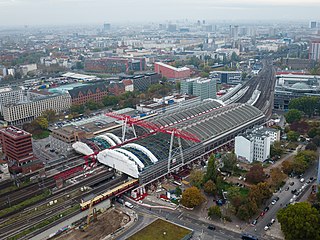
Berlin Ostbahnhof is a main line railway station in Berlin, Germany. It is located in the Friedrichshain quarter, now part of Friedrichshain-Kreuzberg borough, and has undergone several name changes in its history. It was known as Berlin Hauptbahnhof from 1987 to 1998, a name now applied to Berlin's new central station at the former Lehrter station. Alongside Berlin Zoologischer Garten station it was one of the city's two main stations; however, it has declined in significance since the opening of the new Hauptbahnhof on 26 May 2006, and many mainline trains have been re-routed on the North–South mainline through the new Tiergarten tunnel, bypassing Ostbahnhof.

Hannover Hauptbahnhof is the main railway station for the city of Hanover in Lower Saxony, Germany. The railway junction is one of the 21 stations listed as a railway Category 1 station by DB Station&Service. It is also the most important public transport hub of the region of Hanover and it is served regional and S-Bahn services. The station has six platforms with twelve platform tracks, and two through tracks without platforms. Every day it is used by 250,000 passengers and 622 trains stop at the platforms. About 2,000 people work here.

Berlin Jannowitzbrücke is a station in the Mitte district of Berlin. It is served by the S-Bahn lines S3, S5, S7, and S9 and the U-Bahn line U8. It is located next to the Jannowitz Bridge (Jannowitzbrücke) and is a public transport interchange. South of the station is Brückenstraße and north of it are Holzmarkstrasse and Alexanderstraße. The station also serves as a stop for various private excursion and sightseeing boats, among others, those of the Stern und Kreisschiffahrt and Reederei Riedel companies.
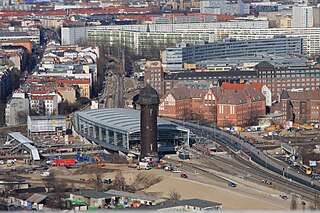
Berlin Ostkreuz station is a station on the Berlin S-Bahn suburban railway and the busiest interchange station in Berlin. It is in the former East Berlin district of Friedrichshain, now part of the borough of Friedrichshain-Kreuzberg. A smaller part of the station is in Rummelsburg, part of the borough of Lichtenberg. The station is a Turmbahnhof with the Berlin–Frankfurt (Oder) railway and the Prussian Eastern Railway on the lower level and the Berlin Ringbahn on the upper level. It is used by a total of around 235,000 passengers every day on eight lines, entering or leaving.

The Berlin Stadtbahn is the historic east-west elevated railway of Berlin. It runs from Friedrichshain in the east to Charlottenburg in the west, connecting several of the most major sights of the German capital. The line is protected cultural heritage since 1995. It is often defined more simply as the slightly longer route between Ostkreuz and Westkreuz, although this is not technically correct.

The Ringbahn is a 37.5 km (23.3 mi) long circle route around Berlin's inner city area, on the Berlin S-Bahn network. Its course is made up of a pair of tracks used by S-Bahn trains and another parallel pair of tracks used by various regional, long distance and freight trains. The S-Bahn lines S41 and S42 provide a closed-loop continuous service without termini. Lines S45, S46 and S47 use a section of the southern and western ring, while lines S8 and S85 use sections of the eastern ring. The combined number of passengers is about 400,000 passengers a day. Due to its distinctive shape, the line is often referred to as the Hundekopf.

Berlin-Spandau station is a Deutsche Bahn station in the Berlin district of Spandau on the south-western edge of the old town of Spandau. The railway junction station is one of the 80 stations classified by Deutsche Bahn as a category 2 station. It has the longest train shed in Germany.
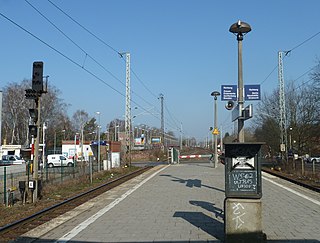
Blankenfelde station is on the Berlin–Dresden railway in the locality of Blankenfelde in the municipality of Blankenfelde-Mahlow in the district of Teltow-Fläming in the German state of Brandenburg. The station consists of two sections that are structurally separate from each other. One section is located just south of the Karl-Marx-Straße level crossing and consists of an island platform for regional and long-distance services. The other section lies north of Karl-Marx-Straße and is the southern terminus of Berlin S-Bahn line S2. On the official S-Bahn maps its name is styled Blankenfelde to avoid possible confusion with Blankenfelde locality in the Pankow district in northern Berlin.

Berlin-Lichterfelde Ost station is on the Anhalt Suburban Line in Lichterfelde in the Berlin borough of Steglitz-Zehlendorf. It is served by S-Bahn line S25, S-Bahn line S26, and Regional-Express lines 3, 4 and 5.
The Schöneweide–Spindlersfeld branch line is a branch line of the Berlin–Görlitz railway, which is entirely in Berlin. The four kilometre long line runs from a junction next to Schöneweide station to two other stations and is served by the Berlin S-Bahn at 20-minute intervals.

The DBAG Class 481/482 is an electric multiple unit train for the Berlin S-Bahn. The class 481 was designed to replace the aging rail cars after the German reunification in 1990. The first mock-up models were presented in 1993 with the first rollout on 22 January 1996.

The DR Class 270 was an electric multiple unit of the Berlin S-Bahn. It was designed for the Deutsche Reichsbahn and was intended to be the replacement for the ageing fleet of S-Bahn units in East Berlin. Test runs were started in 1987 and the first batch was delivered in 1990. After German reunification, Class 270 units were reclassified as DBAG Class 485. A second batch was cancelled in favour of a new design, the DBAG Class 481.

The DR Class ET 169 was the first class of electric multiple units for use on the Berlin S-Bahn commuter lines. 17 five car units were ordered by the Deutsche Reichsbahn in 1925, each comprising two motor cars with bogies and three short four-wheelers. They were intended for service on the northern lines from Stettiner Station to the rural towns Bernau, Oranienburg and Velten.

The BVG Class E was a series of Großprofil multiple units of the Berliner Verkehrsbetriebe (BVG) which was exclusively used on the East Berlin line E, today line U5 of the Berlin U-Bahn. Except for the two prototypes, all vehicles were built using parts of retired S-Bahn vehicles, namely the bogies and parts of the electrical equipment.

The DR Class ET 168 was the second electric multiple unit that operated on the newly electrified Berlin S-Bahn lines. 17 trainsets in total were ordered by the Deutsche Reichsbahn in 1925 for delivery into the northern suburbs of Berlin.
